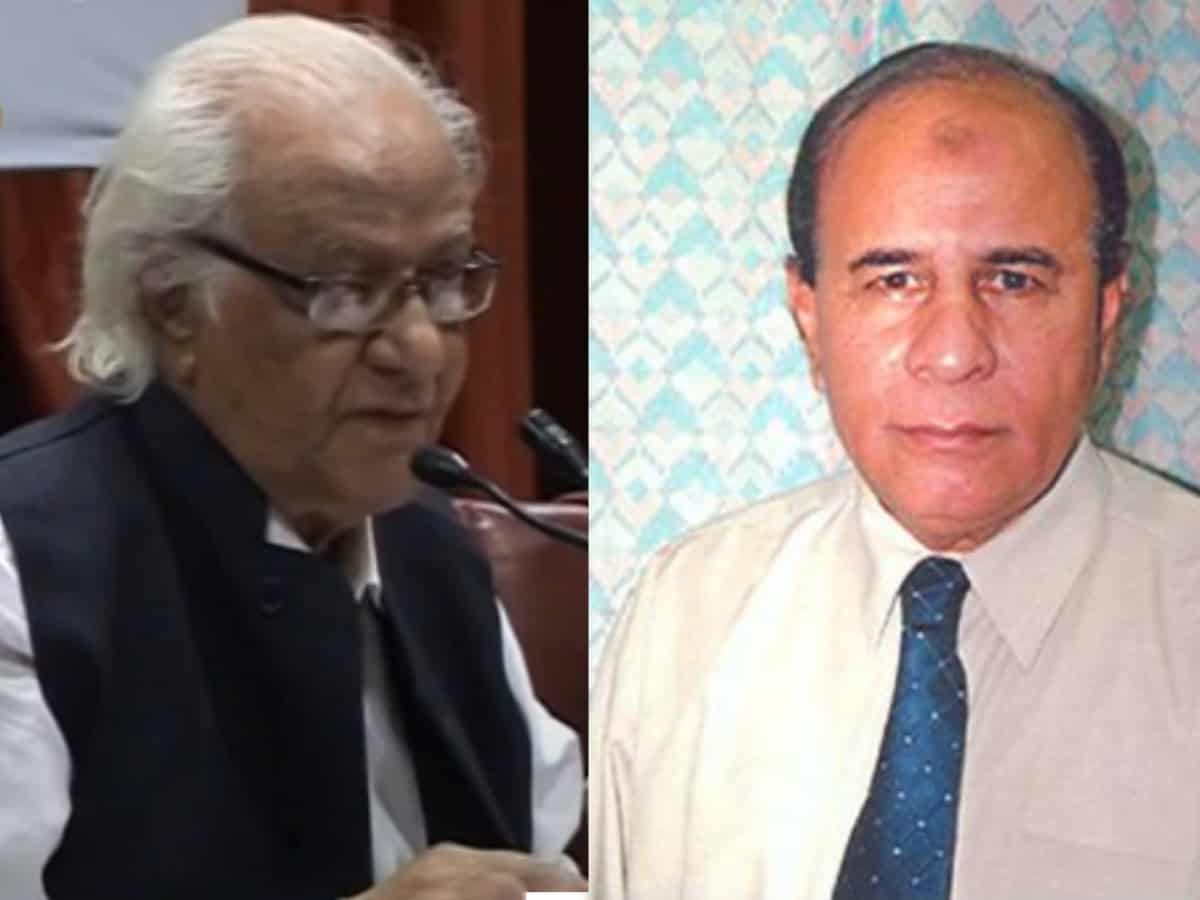
Hyderabad: With the passage of time Sufism has lost its puritanical spirit. Today it has descended into taifa (saint cult hood) phase. The body remains but the soul is gone. Sufism, with its origins deeply rooted in spirituality and the pursuit of divine truth, has undergone significant transformations over the centuries.
Prof. Suleman Siddiqui, former Vice-Chancellor, Osmania University, articulated these changes while delivering the first Anwar Moazzam Memorial Lecture on the theme “Sufism: Past and Present” at Lamkaan on Friday evening.
Prof Anwar Moazzam, an authority on various dimensions of Islam served as the Head of the Department of Islamic Studies at Osmania University in 1960 and 1970s. He also served as Professor of Islamic Studies at Hamdard University in Delhi. He authored numerous articles, papers and books on a variety of dimensions of Islam. He passed away last year at the age of 96 years. He is survived by his writer wife Padma Shree Jeelani Banu and son Ashhar Farhan. Farhan is a multifaceted technocrat and is a senior member the board of directors of Amateur Radio Digital Communications (ARDC).
Prof. Siddiqui, who was a student of late Prof. Moazzam at Osmania University, explored the evolution of Sufi spirituality in early Islam, its transition over centuries and its core principles in an exhaustive lecture. The original essence of Sufism, marked by its puritanical spirit and focus on inner spiritual growth, seems to have faded over time. Modern-day Sufism, Prof. Siddiqui said, has descended into the saint cult hood phase with emphasis shifting from profound spirituality to external rituals and ceremonial practices.
Highlighting his concerns, Prof. Siddiqui pointed to the prevalence of superstitious practices, customs, and rituals at many Sufi shrines today. Events such as sandal processions, ‘jhele ki kasam’ (oath-taking at the shrine), ‘sandal maali’ (ritual offerings), and qawwalis have become commonplace. While these practices may attract devotees, they deviated from the core principles of Sufism, which prioritize personal reflection, inner purification, and a direct connection with the Divine.
The lecture served as a poignant reminder of Sufism’s foundational ideals and its potential to inspire spiritual awakening. Prof. Siddiqui’s observations underscored the need to revisit and revive the original spirit of Sufism in the contemporary era, moving beyond superficial practices to embrace its profound spiritual essence.
Tracing the evolution of Sufism over a period of 1300 years from Arabia to Samarkand, Bokhara, Egypt, and right up to Spain, Prof. Siddiqui explained that Sufism was in its purest form during its early years, remaining within the gamut of Shariah with no alien influences. For the early Sufis, it was a journey from the mundane to the realm of spirituality. Their lives were marked by repentance (tauba) and self-examination (muhasibah), with an emphasis placed more on the inner self than on external rituals. He noted that Sufism is a narrow path for the selected few, prioritizing spiritual discipline and personal reflection.
Prof. Siddiqui, who dwelt at length on the subject, traced the evolution of Sufism during the Makkan period (611-621), Madinian period (621-632) and the period of pious Caliphs – Hazrath Abu Bakar (632-634), Hazrath Umar (634-644), Hazrath Osman (644-656) and Hazrath Ali (656-661). He also referred to the developments in the Umayyad Caliphate (661-750), the Abbasid Caliphate (750-1258), the Ottoman period, Safavid Persian, Khachars, Pehlavis, Mughals (1526-1857) and the provincial States from the Bahmanis to the Asif Jahis. However, the period from 671 to 950 AD is considered the ‘golden era’ since significant expansion of Islam took place during this time.
Who exactly is a Sufi?
According to Persian mystic, Junaid Baghdadi, a Sufi is one who is dead to himself and alive in God. Shibli defines a Sufi as one who has no connection with the world (khalq) as he links himself with God (Haq) alone. “In simple terms a Sufi must have purity of heart, soul and mind,” Prof. Siddiqui remarked.
Sufism, he said, revolves around Pir-Mureed relationship, divine love, contemplation (zikr), meditation (muraqibah), beatific vision (ruyat-e-Bari) and more importantly less of speaking, eating and sleeping. One must necessarily follow the footsteps of the noble Prophet of Islam who was always conscious of the divine presence.
Many have doubts about Sufism being Islamic. Theories abound about its source being Christianity, Buddhism, Parsism and Hinduism. “These are mere assumptions. Truth remains that Sufism is Islamic and is based on the Quran and Sunnah (traditions) of the Prophet,” Prof. Siddiqui clarified.
The seeds of Sufism were sown in Kufa and Basra in Iraq. Three stages marked its growth – Shariah phase (Quietists), the mystic philosophical phase and the Tariqah phase which later became taifah or saint cult hood. The popular Sufi orders include: the Chishtis, the Qadiris, the Shurawardis and the Junaydis.
Great Sufis like Hasan Basari, Abu Hashi, Bayazid Bistani, and Junaid Baghdadi cautioned about the world as they felt it is smooth like a snake but carries deadly venom. Its hopes are lies and expectations false. The Sufis regard hunger and poverty as symbols of righteous and looked upon wealth as an evil which distracted people from their rightful goals. They want God’s will should become one’s will and the commands of God should become man’s command. They spent a life of asceticism (zuhd) and piety. Abu Hashim once remarked that it is easier to pull down a mountain with the help of a needle than to remove vanity and arrogance from one’s heart.
Prof. Siddiqui referred to statements made by sufis in a state of intoxication (intense love of God) which would attract a fatwa of kufr. For instance Bayazid Bistani regarded his mystic experience as ‘miraj’ (ascension) while Mansur al-Hallaj said ‘anal Haq’ (I am the creative truth). On the other hand Junaid of Baghdad advocated sobriety of mind (sahw) as opposed to intoxication (sukr). Abdul Qadir Jilani spoke of ilm al-yaqeen (knowledge of certainty), ayn al-yaqeen (personal experience) and haq al-yaqeen (intuition) in his renowned book Ghuniyat ut-talibeenn.
Prof. Siddiqui also touched upon the theory of Wahdat al-wujud (ontological unity) and Wahdat al-shuhud (monotheism of witness) and how the 18th century Sufi, Shah Waliullah Dehlawi tried to bring about reconciliation between the two. In India Sufism reached through Iraq, Iran and Afghanistan and flourished during the Mughal period. The early Chishti khanqahs at Ajmer, Pakpatan, Ajhodan and Delhi were the focal point in propagation of Islam since they revolved around spirituality, fervour, ascetic exercises, morality and mystic training. Khwaja Moinuddin Chishti once remarked that one should possess generosity of the ocean, compassion of a sun and humility of the earth. “But we are far away from these qualities,” Prof. Siddiqui deplored.
He lamented that a large number of Muslims today are not aware of Sufism and its various orders which have played a significant role in shaping Islamic spirituality. The younger generation is unaware of the rich body of literature available in Urdu that deals with Quran, Tafsir, Hadith, Fiqh, Sufism and Philosophy. He urged Muslims to reconnect with these sources of knowledge to enrich their understanding of Islam.



